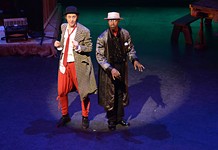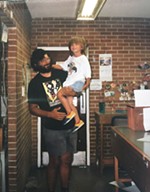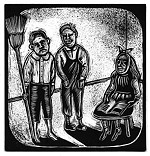A View From the Bridge: Go Away, Little Girl
Local Arts Reviews
Reviewed by Ada Calhoun, Fri., Nov. 5, 1999

A View From the Bridge: Go Away, Little Girl
B. Iden Payne Theatre
October 28
Arthur Miller's A View From The Bridge was first staged in 1956, within a year of the playwright's appearance before the House Un-American Activities Committee and within five years of his divorce from Marilyn Monroe. Through Miller's skill, the panic of the McCarthy era and the all-knowing aesthetic of Greek tragedy meld in such a way as to convey a plethora of eternal truths: The old are jealous of the young; girls at the brink of womanhood are simultaneously at their most powerful and least self-aware; obligation and honor are acceptable motivating forces; the government (here in the form of the immigration agency) is forever howling at the gates.
Professionally produced by Houston's Alley Theatre and expertly directed by Stephen Rayne, the play opens with our narrator, the well-respected neighborhood lawyer Alfieri (played by the compelling Noble Shropshire), forewarning us that an epic story is about to transpire. Like most mythic tragedies of yore, A View From the Bridge focuses on a doom-ridden family and the community in front of which that household all-too-publicly disintegrates.
In this case, the family is the working-class-Italian Carbone clan, and the community is Red Hook, Brooklyn, circa 1955. At issue is the emerging sexuality of the Carbones' 17-year-old ward Catherine, who has begun to wear high heels and to walk "wavy." Guardian Uncle Eddie's all-consuming adoration for his niece evolves into a lusty force stronger than all the wise counsels, desperate pleas, and bad omens in the world. James Black earned his standing ovation with a shuddering portrayal of Eddie that was at once endearing and horrific. Faced with Eddie's passion, Catherine is understandably both profoundly disturbed and subtly intrigued by her newfound power. This perplexity was deftly conveyed by actress Sabrina Veroczi, though her fluttery demeanor and particularly her inconsistent Italian accent pegged her as someone slightly too high class for Red Hook.
Forgotten amid the drama between Eddie and Catherine, the long-suffering Aunt Bea (played by the impeccable Annalee Jefferies) is devastated. The arrival of her immigrant cousins from Italy suggests salvation when the handsome and talented Rodolpho, the very antithesis of the stained-undershirt-clad Eddie, takes an interest in Catherine. Inevitably, though, the new figures in the household only intensify Eddie's fears about Catherine's burgeoning womanhood.
Chris Henry Coffey played giddily with the ambiguous sexuality (by Red Hook standards) of Rodolpho, the fun-loving sharp dresser who can tailor clothes, cook, and sing "Paper Doll." Kevin Waldron was a terrifically imposing presence as Marco, Rodolpho's hard-working and sullen brother. All in all, the Alley Theatre's production, led by James Black, pulled off a slick and moving rendition of Miller's play, convincingly conveying the untold havoc sexual obsession can wreak.










